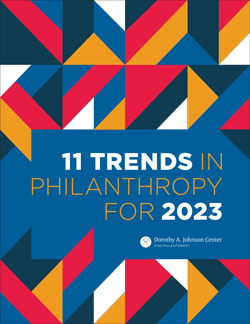Rethinking What Capacity Building Should Be — and Who Should Decide


 This article was first published in our 11 Trends in Philanthropy for 2023 report. Explore all 11 trends in the report.
This article was first published in our 11 Trends in Philanthropy for 2023 report. Explore all 11 trends in the report.
Want the latest trends, research, and more delivered right to your inbox? Subscribe to the Johnson Center email newsletter.
Ever since Lester Salamon rang the first alarm bell about organizational infrastructure challenges in 1999, noting that “U.S. nonprofits face a crisis of effectiveness” (p. 12), the sector has tried to come to terms with what capacity building is and how best to do it.
While the work of capacity building has grown over the past several decades, philanthropy has failed to agree on a single definition. It has been defined simply as any “actions that improve nonprofit effectiveness” (Blumenthal, 2003, p. 5), or, from the funder’s perspective, “as the funding and technical assistance to help nonprofits increase specific capabilities to deliver stronger programs, take risks, build connections, innovate and iterate” (Grantmakers for Effective Organizations [GEO], 2016, p. 3).
“[T]raditional, foundation-funded capacity building is increasingly criticized for its origins in white dominant culture and its continued practice of serving white-led nonprofits.”
Often driven by institutional funders, capacity building could include training for members of the board of directors, developing a strategic plan, or even building a website. However, this traditional, foundation-funded capacity building is increasingly criticized for its origins in white dominant culture (EchoHawk, 2019; Community Wealth Partners, 2021; Le, 2020; Littles, 2022, Taylor, Coolidge, & Valerio, 2022) and its continued practice of serving white-led nonprofits. Power and equity are at the center of a growing movement to reimagine the language and practices of capacity building.
As pointed out in a 2018 report by the Delta Vision project, traditional models of capacity building “often overlook the roles and responsibilities of funders, policy-making entities, and system actors …. [and are] inadequate for communities of color” (p. 2). As Vu Le reminds us, “what we are doing may have worked in the past, but it may be irrelevant or even harmful to do the same things now” (2020, para. 6).
In an effort to reduce the harm that traditional models of capacity building may cause, Le and the leadership of RVC (Rooted in Vibrant Communities, an organization Le founded) called for a new definition of capacity building in a 2020 article in the Stanford Social Innovation Review (Nishimura et al.). Grounded in equity and power sharing, the RVC team focuses their idea of capacity building on “the process of building and strengthening the systems, structures, cultures, skills, resources, and power that organizations need to serve their communities” (Nishimura et al., 2020, p. 32).
This rethinking of capacity building was picked up by GEO in their 2021 report, Reimagining Capacity Building: Navigating Culture, Systems & Power, wherein they called upon funders to rethink traditional models of capacity building that are built on practices designed by and for a sector that is overwhelmingly dominated by white leadership. The inequity in the sector is an extension of what is baked into the broader society, yet “capacity builders may not explicitly consider how inequities might factor into the design and implementation of an initiative or project” (GEO, 2021, p. 33).
As the country and our sector continue to wrestle with dismantling white supremacy, capacity builders themselves are taking stock of their own work. In a 2022 article for Nonprofit Quarterly (NPQ), Melissa DeShields, CEO of Frontline Solutions, shared her own “crisis of conscience,” posing the question “who gets to decide what constitutes effectiveness?” (para. 8) as we seek to build capacity.
The 2022 annual conference of the Alliance for Nonprofit Management, the only membership organization in the country specifically for nonprofit capacity builders, called on participants to continue disrupting the status quo “in a hopeful way and create new futures in nonprofit capacity building” (para. 2). Marcus Littles, founder of Frontline Solutions, went one step further in a 2022 NPQ article, asking if we should “cancel capacity building” altogether due to the idea that it comes with an “often unspoken assumption … that the funder knows best” (para. 6).
To combat this assumption, GEO (2021) proposes that funders and grantees intentionally co-create solutions in capacity building, balancing power as well as building trust-based relationships, peer learning, and encouraging longer-term support. Still, many of the practices that have reinforced the existing power dynamic persist. A 2021 study from the Center for Effective Philanthropy, for instance, found that while many foundations note positive changes in funding practices as a result of the pandemic, “just 27 percent — are providing more multiyear unrestricted support” (Buteau et al., p. 13). Even fewer are doing so alongside capacity building/organizational effectiveness grants (Orensten & Gehling, 2021).
While this desire for more unrestricted funding of nonprofits is nothing new, the connection between those dollars and capacity building is part of the growing call to rethink this work. In Making Capacity Building More Equitable: A Field Guide for Funders (2021), Community Wealth Partners prefaced their report with the emphatic statement that “multi-year, unrestricted grants are capacity-building grants” (p. 3), particularly for BIPOC-led organizations that have historically received only a fraction of funding compared to their white-led counterparts.
Centering Black-, Brown-, and Indigenous-led organizations is at the heart of the growing call to rethink capacity building because “sustainable institutions are not built by identifying organizational deficits that racism and patriarchy have contributed to creating” (Little, 2022, para. 6). Moving to a more asset-based approach that is set in the context of the broader system may help build trust and shift some of the power from grantmakers to nonprofits.
GEO (2021) suggests that shifting grantmaking to a race equity lens will help foundations and capacity building consultants move away from assessments that focus on pre-determined avenues of work and “readiness” and create greater access to the tools and resources that smaller organizations need for sustainability and growth. Williams (2021) reported that based on the IRS 2020 data, over 50% of nonprofits in this country operate with an annual revenue of less than $50,000. Creating more access could have a significant impact on communities across the country.
Increased impact is what capacity building should be about and it will require a radical shift in assumptions and cultural norms moving forward. The sector is being asked to rethink the very nature of capacity building, such as centering care, wellness, and rest as part of racial equity (BIPOC Ed Coalition, 2021). The BIPOC Ed Coalition’s (2022) Sabbatical Program and the Transforming Solidarity Collective’s (2021) community dialogues on Rest & Liberation have provided dedicated time for nonprofit employees of color to care for themselves as a way of investing in capacity and sustainability in their organization while recognizing the inherent value of the people that make up nonprofit communities and transforming the culture at the root of systemic inequities.
“Given how entrenched racial inequities are in our field and the historical roots of … inequities, we are long overdue for a reckoning — one that requires us to examine our own privilege and to reflect on the ways we can share power, honor cultural nuance, and reimagine systems and structures that currently reinforce inequities” (GEO, 2021, p. 47).


Alliance for Nonprofit Management. (n.d.). 2022 Alliance for Nonprofit Management conference: Creating new futures for nonprofit capacity building. October 27-28 + November 10, 2022. https://allianceonlinecommunity.org/page/annual-conference
BIPOC Ed Coalition. (2021, December). Sabbaticals for BIPOC leaders: Capacity building, healing, renewal. https://bipocedcoalitionwa.org/wp-content/uploads/2022/01/Sabbaticals-for-BIPOC-Leaders.pdf
BIPOC Ed Coalition. (2022, October 11). Making real the radical act of rest: Announcing our 2022 sabbatical leadership and respite awardees. https://bipocedcoalitionwa.org/news/2022-sabbatical-announcement/
Blumenthal, B. (2003). Investing in capacity building: A guide to high-impact approaches. Foundation Center.
Buteau, E., Orensten, N., & Marotta, S. (2021, November). Foundations respond to crisis: Lasting change? Center for Effective Philanthropy. https://cep.org/wp-content/uploads/2021/11/CEP_Foundations-Respond-to-Crisis_Lasting_Change.pdf
Community Wealth Partners. (2021, October). Making capacity building more equitable: A field guide for funders. https://communitywealth.com/wp-content/uploads/2021/10/Making-Capacity-Building-More-Equitable-Field-Guide.pdf
The Delta Vision Project. (2018, June 30). The Delta Vision: Building capacity for and by communities of color. https://communities-rise.org/wp-content/uploads/2021/05/NAC_Delta_Exec_Summary_DRAFT11_web.pdf
DeShields, M. (2022, August 23). A capacity builder’s crisis of conscience. Nonprofit Quarterly. https://nonprofitquarterly.org/a-capacity-builders-crisis-of-conscience/
EchoHawk, S. (2019, October 28). Unpacking capacity building. Nonprofit Quarterly. https://nonprofitquarterly.org/unpacking-capacity-building/
Grantmakers for Effective Organizations. (2016, September 15). Strengthening nonprofit capacity. https://www.geofunders.org/resources/strengthening-nonprofit-capacity-710
Grantmakers for Effective Organizations. (2021, October 20). Reimagining capacity building: Navigating culture, systems & power. https://www.geofunders.org/resources/reimagining-capacity-building-navigating-culture-systems-power-1340
Le, V. (2020, October 12). Capacity building’s necessary existential crisis. Nonprofit AF. https://nonprofitaf.com/2020/10/capacity-buildings-necessary-existential-crisis/
Littles, M. (2022, September 13). Should we cancel capacity building? Nonprofit Quarterly. https://nonprofitquarterly.org/should-we-cancel-capacity-building/
Nishimura, A., Sampath, R., Vu, L., Mahar Sheikh, A., & Valenzuela, A. A. (2020, Fall). Transformational capacity building. Stanford Social Innovation Review, 18(4), 30–37. https://rvcseattle.org/wp-content/uploads/2020/10/Fall2020-Feature-Nishimura-Capacity-Building_1.pdf
Orensten, N. & Gehling, K. (2021). Strengthening nonprofits: The value of complementing multiyear GOS grants with capacity building supports. Center for Effective Philanthropy. https://cep.org/strengthening-nonprofits-the-value-of-complementing-multiyear-gos-grants-with-capacity-building-supports/
Salamon, L. (1999, March). The nonprofit sector at a crossroads: The case of America. Voluntas: International Journal of Voluntary and Nonprofit Organizations 10(1), 5–23. https://doi.org/10.1023/A:1021435602742
Taylor, C., Coolidge, M., & Valerio, L. (2022, September 20). Redesigning capacity building: How philanthropy must support leaders of color. Nonprofit Quarterly. https://nonprofitquarterly.org/redesigning-capacity-building-how-philanthropy-must-support-leaders-of-color/
Transforming Solidarity Collective. (2021, September 16). Rest & liberation: A community dialogue. https://cdaod.wildapricot.org/event-4464420
Williams, J. (2021, November 30). How to exclude nonprofits without even trying: Grant eligibility requirements narrow your pool. Dorothy A. Johnson Center for Philanthropy. https://johnsoncenter.org/blog/how-to-exclude-nonprofits-without-even-trying-grant-eligibility-requirements-narrow-your-pool/